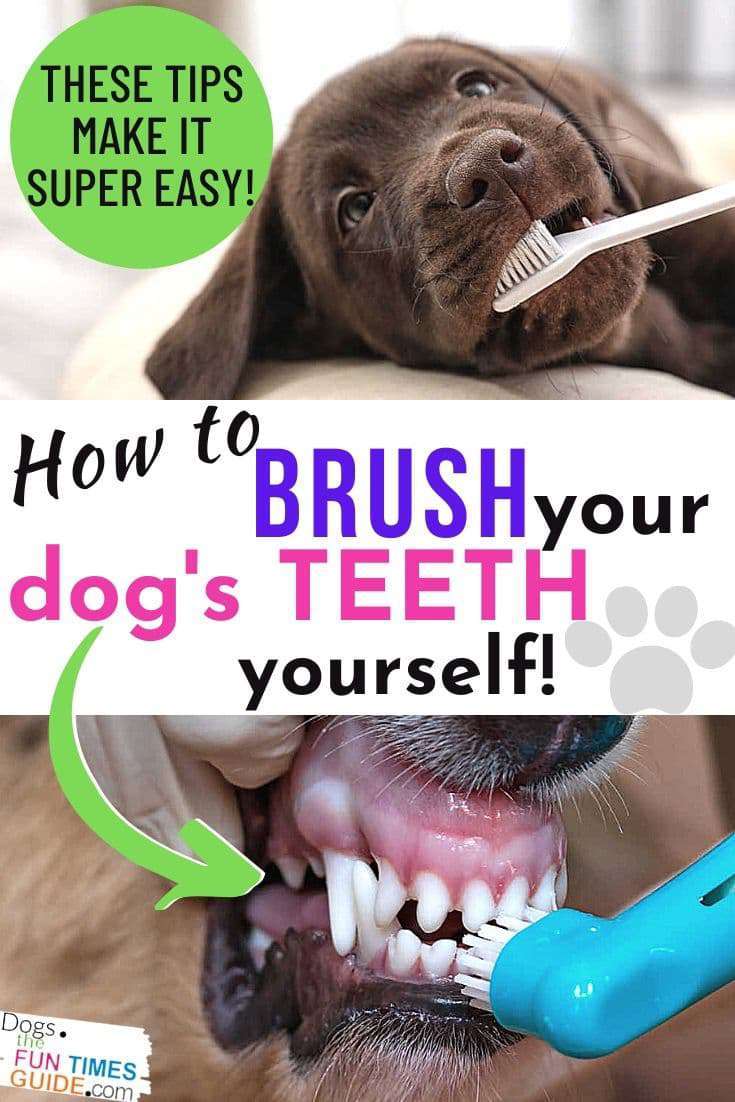Have you been wondering how in the world you’re going to accomplish the task of brushing your dog’s teeth?
Today, I’m going to teach you how to clean your dog’s teeth… yourself.
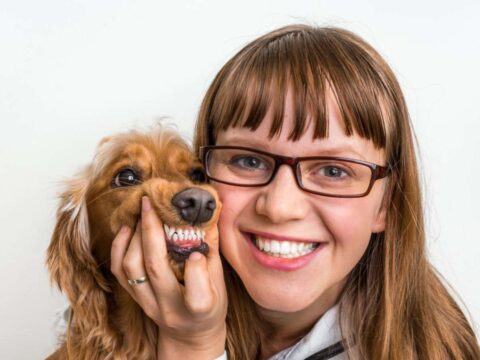
Below are all of our best tips (and videos) showing how to brush your dog’s teeth… and get him to enjoy it!
The end result of regularly cleaning your dog’s teeth:
- A happier, healthier dog
- Better looking teeth
- Better smelling breath
- A dog that lives longer
…compared to dogs that don’t get their teeth brushed regularly.
Reasons To Brush Your Dog’s Teeth
It’s true… Your dog’s teeth must be kept in good condition if you want him to live a long, healthy life.
It’s said that brushing your dog’s teeth can add 5 years to their life!
How?
Because serious plaque on your dog’s teeth is a sign that there’s bacteria leaching into your dog’s entire body — starting in the mouth and traveling elsewhere.
Things like gum disease and tooth decay are often hard to see. So are kidney disease and heart disease! Those are the areas most commonly affected by a dog’s poor dental care.
Plaque is a gummy substance that forms on the teeth within a few hours after a meal. Within 24 hours, plaque begins to harden by combining with salts that are present in the saliva. As the plaque continues to accumulate and mineralize, it eventually transforms into tartar. Tartar, also called calculus, is rough and porous and can develop above and below the gum line.
–VCA Animal Hospitals
So, yes… your dog’s general health is directly influenced by how healthy their teeth and gums are.
Once infection sets in, it can sometimes be difficult to treat — which could compromise your dog’s health in other ways, described here:
According to the American Veterinary Dental Society, 80% of dogs have active dental disease by age 3. (Bad breath is one of the first signs.)
Trust me, you do not want to let plaque and tartar build up on your dog’s teeth!
See what gum disease in dogs and bone loss requiring extraction of the teeth looks like.
Okay, so those are the most common reasons to brush your dog’s teeth.
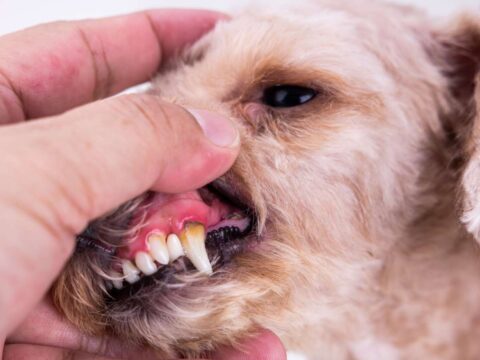
Here’s yet another reason to brush your dog’s teeth: you could detect a cancerous tumor in your dog’s mouth early enough to save your dog’s life! (Yes, these are relatively common in dogs with poor dental care.)
Inflammation from too much bacteria in your dog’s mouth is a precursor to tumors. If there is a lot of infection and toxicity, the gums can become inflamed and eventually grow tumors.
—Dr. Peter Dobias, DVM
Here’s the bottom line on why you should brush your dog’s teeth…
Just imagine if you stopped brushing your own teeth. Eeeew! Well, your dog’s teeth are no different. Teeth are teeth. Plaque is plaque. Tartar is tartar.
What Are The Options For Cleaning A Dog’s Teeth?
There are 2 ways to maintain healthy dog teeth:
- Brush your dog’s teeth yourself regularly (using simple dog teeth brushing tools that won’t remove set-in stains).
- Have your dog’s teeth cleaned by a veterinarian occasionally (using professional equipment that removes set-in stains).
A professional dog teeth cleaning isn’t cheap. So it’s best to do it yourself. You should brush your dogs teeth at least 2x each week — even if it’s a quick wipe!
TIP: If you see tartar on your dog’s teeth, you will NOT be able to brush it off. Only professional tools can remove tartar from your dog’s teeth. If you don’t see tartar, then that is the right time to brush your dog’s teeth yourself. (Bad breath is a sign that you can’t wait any longer.)
By the way, plaque doesn’t only appear on the surface of your dog’s teeth, but underneath the gums as well. That’s why a professional dental cleaning is required once the plaque is visible — because it means there are even more serious tartar issues happening below the gums.
When To Brush Your Dog’s Teeth
If possible, start brushing your dog’s teeth when he’s still a puppy — or within the first week of bringing your new dog home. (Seriously. You’ll thank me later!)
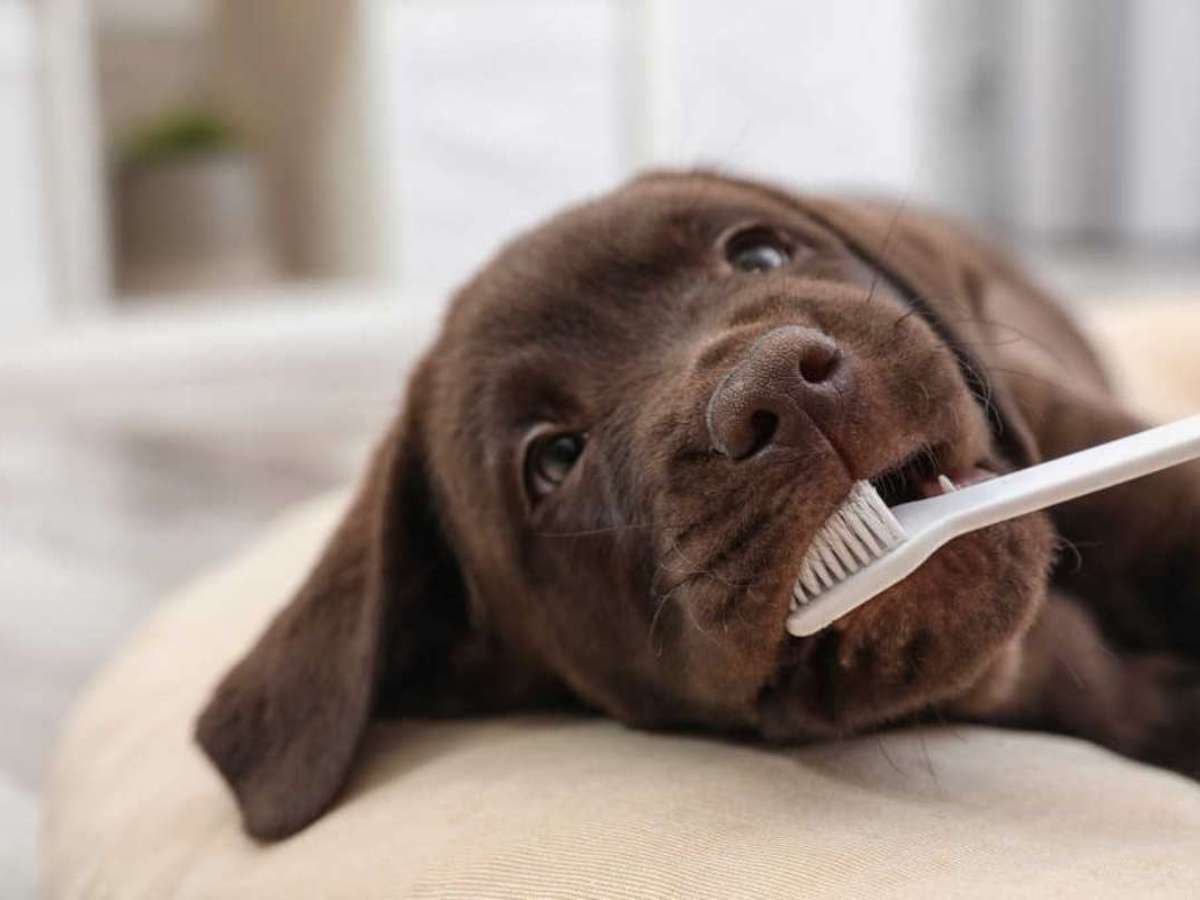
That way, your dog will get used to the process early. He will quickly learn that teeth brushing is a normal activity around here and it’s done quite a lot! And the best part is… before long, he won’t even resist it anymore. (My 2 sibling pups are 6 years old now and they LOVE having their teeth brushed — mostly because they like getting one-on-one time with me AND they know what to expect when I show them the toothbrush.)
At first, your efforts will seem fruitless. And your dog’s not gonna like it. But after you do it a little bit at a time for several days in a row, he will get used to it.
Remember this:
- The dogs that don’t mind having their teeth cleaned today are the dogs that have had their teeth brushed since puppyhood.
- The dogs that put up the biggest fight and resist having their teeth brushed are the ones that are not used to having it done.
So, it’s definitely best (for your own sanity, your dog’s health, and your wallet) to start brushing your dog’s teeth sooner rather than later!
How To Brush Your Dog’s Teeth: Step By Step
- First, get your dog used to the process of having your fingers in and around his mouth.
This video shows you how to get your dog used to having things in his mouth:
- Then, follow these tips focusing on how to clean your dog’s teeth, step-by-step:
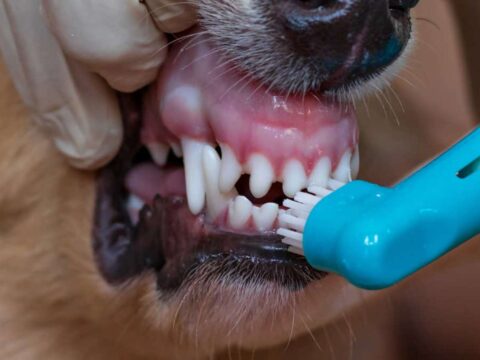
- Put a little bit of dog toothpaste (NOT human toothpaste!) on your finger and simply allow your dog to lick some of it off. By the way, the top 4 dog toothpaste brands recommended most often by veterinarians are: (1) Virbac CET enzymatic toothpaste, (2) Vet’s Best enzymatic dog toothpaste, (3) Oxyfresh pet toothpaste, and (4) Petrodex dog toothpaste.
- Next, put some dog toothpaste on a dog toothbrush (dog toothbrushes are angled differently and easier to use than human toothbrushes). Or use a dog finger brush — my favorite is this one because the little silicone bristles are on all sides. I sometimes use an electric toothbrush (this one) — if you decide to go this route, be sure to get one that has a smallish round brush head, not oval, because that would be too “long” to maneuver comfortably inside a dog’s mouth.
- Do NOT brush your dog’s teeth like you brush your own teeth. Instead, just smear the toothpaste on your dog’s tooth (where the tooth meets the gum line) — 1 tooth at a time. Dog toothpaste is made to dissolve plaque without much rubbing or scrubbing. A brush simply helps you reach the back teeth better and apply the toothpaste quicker, that’s all. (Also, you only need to clean the outside of your dog’s teeth — because your dog’s tongue and saliva naturally take care of cleaning the inside.)
- If the first tooth went well, then try the same thing on another tooth. Until your dog gets used to having his teeth brushed, you may want to do only a few teeth at a time in one sitting. That will prevent you or your dog from getting too stressed out.
Most dogs (mine included) absolutely love the taste of dog toothpaste and will beg for more of it!
That’s good, because you want the experience to be a positive one for your dog. So keep giving your dog lots of praise every time you get another tooth done. Then, at the very end of the tooth brushing session, give your dog one of his all-time favorite dog treats as a reward for getting his teeth cleaned.
TIP: You might only get 1 or 2 teeth brushed without your dog squirming away or chomping down out of frustration. That’s okay. That counts as a “session” and your dog deserves a treat for it. Just remember to pick up where you left off later in the day… or the next day. Don’t let your dog “win” by convincing you that teeth brushing isn’t worth it. It is worth doing!
Brushing your dog’s teeth when your dog doesn’t like it is NOT torturing your dog. You are HELPING your dog! You need to have that firmly ingrained in your mind in order for dog teeth brushing to work.
~ Dr. Peter Dobias, DVM
This video shows you exactly how to brush a dog’s teeth (lots of good tips here!):
So now it should be clear how you can use different types of dog toothbrushes and dog toothpastes to keep your dog’s teeth looking great. (Plus, a few good ways to keep your dog’s breath smelling fresh!)
The bottom line…
Yes, you can clean your dog’s teeth yourself!
How To Clean Your Dog’s Teeth Naturally
Are you wondering how to clean dog teeth without brushing them?
Well, in between your dog teeth brushing sessions (or professional teeth cleanings), you can help keep your dog’s teeth clean by giving him:
- “The right” chew toys
- “Safe” dog bones
- “Healthy” dog food & treats
- “Over-the-counter” plaque removers
Here are examples of each…
Toys That Brush Dog Teeth Effortlessly

Examples of toys that help clean dog teeth include:
When your dog bites and chews on these types of toys, it helps to remove the plaque from the teeth and gums.
My personal favorite dog toy that works really well at brushing your dog’s teeth is the Bristly Brushing Stick. (I have 2 of the Bristly sticks and 2 other knock-offs that are similar — without a doubt, the Bristly dog tooth brushing toy works the best!)
A proper dental chew can reduce plaque by up to 69%.
— Gail Rapport, DVM
Food & Bones That Help Clean Dog Teeth
Feeding your dog dry kibble (instead of soft dog food) helps, too — but it only helps a little bit. It’s definitely no substitute for brushing your dog’s teeth!
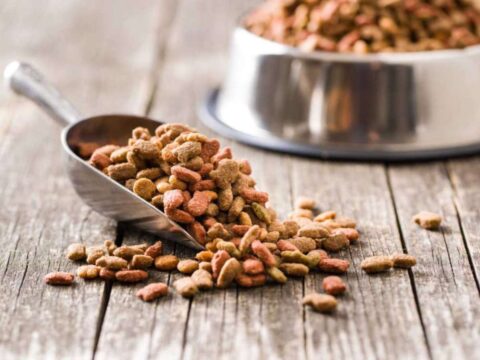
As an example… Imagine what happens if you eat a hard, dry cookie and don’t brush your teeth. The cookie leaves plaque behind. And without removing the plaque, your teeth will start to form tartar on them.
The best food-related treats that are good for your dog’s teeth are raw bones — especially if they have bits of meat still on them. Your dog will get some “extra” teeth cleaning done while trying to remove all of the meat and tendons that are attached to the bone. Just be sure to stay away from cooked bones!
These are the best raw bones for dogs:
- For Small Dogs: necks, wings, thighs from chickens, lambs, turkeys, or ducks
- For Medium & Large Dogs: lamb bones, goat bones, or large beef ribs (just be sure to supervise and remove once it’s small enough to fit entirely inside your dog’s mouth)
I get most of my raw dog bones from a local butcher — sometimes at the grocery store. (I didn’t realize until recently that you can just ask someone in the meat department. They really don’t mind.)
The second best form of dog bones are antlers and horns from large animals. (TIP: Try soaking them in chicken broth first to soften them a bit!)
I also give both of my dogs cow hooves and bully sticks because they’re long-lasting and my dogs’ teeth get worked (and cleaned!) from all angles over a long period of time.
The takeaway here with regard to giving your dog bones is to stay away from cooked bones and traditional rawhide bones.
NOTE: Pressed rawhide is a little better than those bleached white rawhide bones — but not as good as raw bones, horns, and antlers.
Special Products That Remove Dog Tooth Plaque
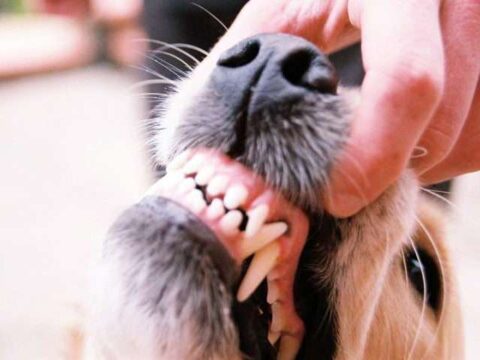
There are some dog-safe products that help to loosen and remove the plaque from your dog’s teeth.
The reviews on these types of products are mixed — because the claims made on the packaging are often exaggerated. Nothing truly removes plaque as well as physically brushing your dog’s teeth or having them professionally cleaned.
If you wish to make the task of cleaning your dog’s teeth a little easier, these are the most popular (recommended by veterinarians that I know) dog tooth plaque remover products:
- Proden Plaque Off (powdered granules that you add to your dog’s food)
- Zymox Oratine Drinking Water Additive (a liquid that you add to your dog’s water — see my review of dog mouthwashes)
- Newton Homeopathics Doggy Breath Drops (completely natural)
The Bottom Line
So, are you going to start brushing your dog’s teeth more regularly now? I sure hope so.
If you really don’t like brushing your dog’s teeth, then at the very least do this:
- Get your dog some durable toys with nubs and crevices that will help clean your dog’s teeth — like the Bristly dog toothbrush toy.
- Feed your dog healthy food — with good ingredients.
- Give your dog bones that are safe — raw bones not cooked bones.
- Use your finger to rub dog-safe toothpaste onto your dog’s teeth as often as you can — coconut oil works well too! (In fact, it’s the best DIY dog toothpaste because it’s antibacterial and healthy, just don’t give too much of at once to your dog or they’ll get diarrhea. I keep a small jar of it with my dog’s grooming supplies.)
- Or, if you’re really struggling, try dog tooth wipes — they’re easy to use. (You could also put some coconut oil on a gauze pad and brush your dog’s teeth that way!)
If you’ve been brushing your dog’s teeth for awhile, do you have any other time-saving or money-saving tips to share with fellow dog owners? If so, please share in the comments below!
Like this post? Save it to read again later… or share with others on Pinterest!
